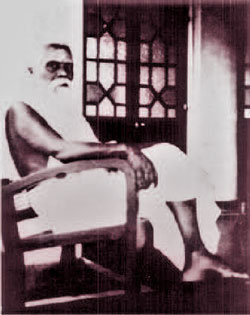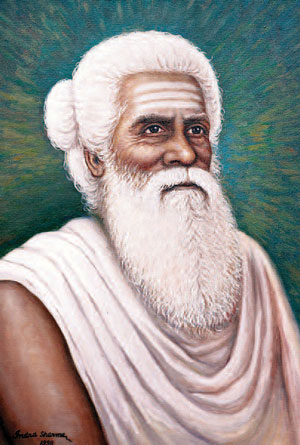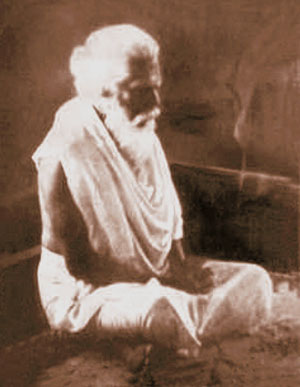
[Siva Yogaswami of Jaffna (1872–1964) was a Sri Lankan spiritual master revered by men and women of many faiths. The Editors]
The Tamils of Sri Lanka called him the Sage of Jaffna. His thousands of devotees, including many Sinhalese Buddhists and Christians, called him a saint. Some of those closest to him referred to him as the Old Lion, or Bodhidharma reborn, for he could be very fierce and unpredictable, chasing away unwelcome supplicants with a stick. I just called him Swami. He was my introduction to Hinduism in its pure Vedanta form, and my teacher for the nearly four years I served as the Canadian High Commissioner in what was still called Ceylon in the early Sixties when I was there.
For the previous ten years I had been apprenticed in the Gurdjieff Work, and it was through a former student of P.D. Ouspensky, James Ramsbotham (Lord Soulbury), and his brother Peter, that, one hot afternoon, not long after our arrival in Ceylon, I found myself outside a modest thatched hut in Jaffna, on the southern shore of Ceylon, to keep my first appointment with Yogaswami.
I knocked quietly on the door, and a voice from within roared, “Is that the Canadian High Commissioner?” I opened the door to find him seated cross-legged on the floor—an erect, commanding presence clad in a white robe, with a generous topping of white hair and a long white beard. “Well, Swami,” I began, “that is just what I do, not what I am.” “Then come and sit with me,” he laughed uproariously.
 I felt bonded with him from that moment. He helped me to go deeper towards the discovery of who I am, and to identify less with the role I played. Indeed, like his great Tamil contemporary, Ramana Maharshi of Arunachalam, in South India, Yogaswami used “Who am I?” as a mantra as well as an existential question. He often chided me for running around the country, attending one official function after another, and neglecting the practice of sitting meditation. When I got back to Ceylon from home leave in Canada, after visiting, on the way around the planet, France, Canada, Japan, Indonesia, and Cambodia, he sat me down firmly beside him and told me that I was spending my life-energy uselessly, looking always outward for what could only be found within.
I felt bonded with him from that moment. He helped me to go deeper towards the discovery of who I am, and to identify less with the role I played. Indeed, like his great Tamil contemporary, Ramana Maharshi of Arunachalam, in South India, Yogaswami used “Who am I?” as a mantra as well as an existential question. He often chided me for running around the country, attending one official function after another, and neglecting the practice of sitting meditation. When I got back to Ceylon from home leave in Canada, after visiting, on the way around the planet, France, Canada, Japan, Indonesia, and Cambodia, he sat me down firmly beside him and told me that I was spending my life-energy uselessly, looking always outward for what could only be found within.
“You are all the time running about, doing something, instead of sitting still and just being. Why don’t you sit at home and confront yourself as you are, asking yourself, not me, “Who am I? Who am I? Who am I? Who am I? Who am I? Who am I?” His voice rose in pitch, volume, and intensity with each repetition of the question until he was screaming at me with all his force.
Then suddenly he was silent, very powerfully silent, filling the room with his unspoken teaching that went far beyond words, banishing my turning thoughts with his simple presence. In that moment I knew without any question that I AM; and that that is enough; no “who” needed. I just am. It is a lesson I keep having to relearn, re-experience, for the “doing” and the “thinking” take me over again and again as soon as I forget.
Another time my wife and I brought our three children to see Yogaswami. Turning to the children, he asked each of them, “How old are you?” Our daughter said “Nine,” and the boys, “Eleven” and “Thirteen.” To each in turn Yogaswami replied solemnly, “I am the same age as you.” When the children protested that he couldn’t be three different ages at once, and that he must be much older than their grandfather, Yogaswami just laughed, and winked at us, to see if we understood.
At the time we took it as his joke with the children, but slowly we came to see that he meant something profound, which it was for us to decipher. Now I think this was his way of saying indirectly that although the body may be of very different ages on its way from birth to death, something just as real as our body and for which the body is only a vehicle, always was and always will be. In that sense, we are in essence all “the same age.”

Although I had met Yogaswami many times, I learned to prepare my questions carefully. One day, when I had done so, I approached his hut, took off my shoes, went in and sat down on a straw mat on the earth floor, while he watched me with the attention that never seemed to fail him. “Swami,” I began, “I think…” “Already wrong!” he thundered. And my mind again went into the nonconceptual state that he was such a master at invoking, clearing the way for being.
Looking at the world as it is now, thirty years after his death, I wonder if he would utter the same aphorisms with the same conviction today. I expect he would, challenging us to go still deeper to understand what he meant. Reality cannot be imperfect or wrong; only we can be both wrong and imperfect, when we are not real, when we are not now! ♦
Reprinted by permission from Hinduism Today.
